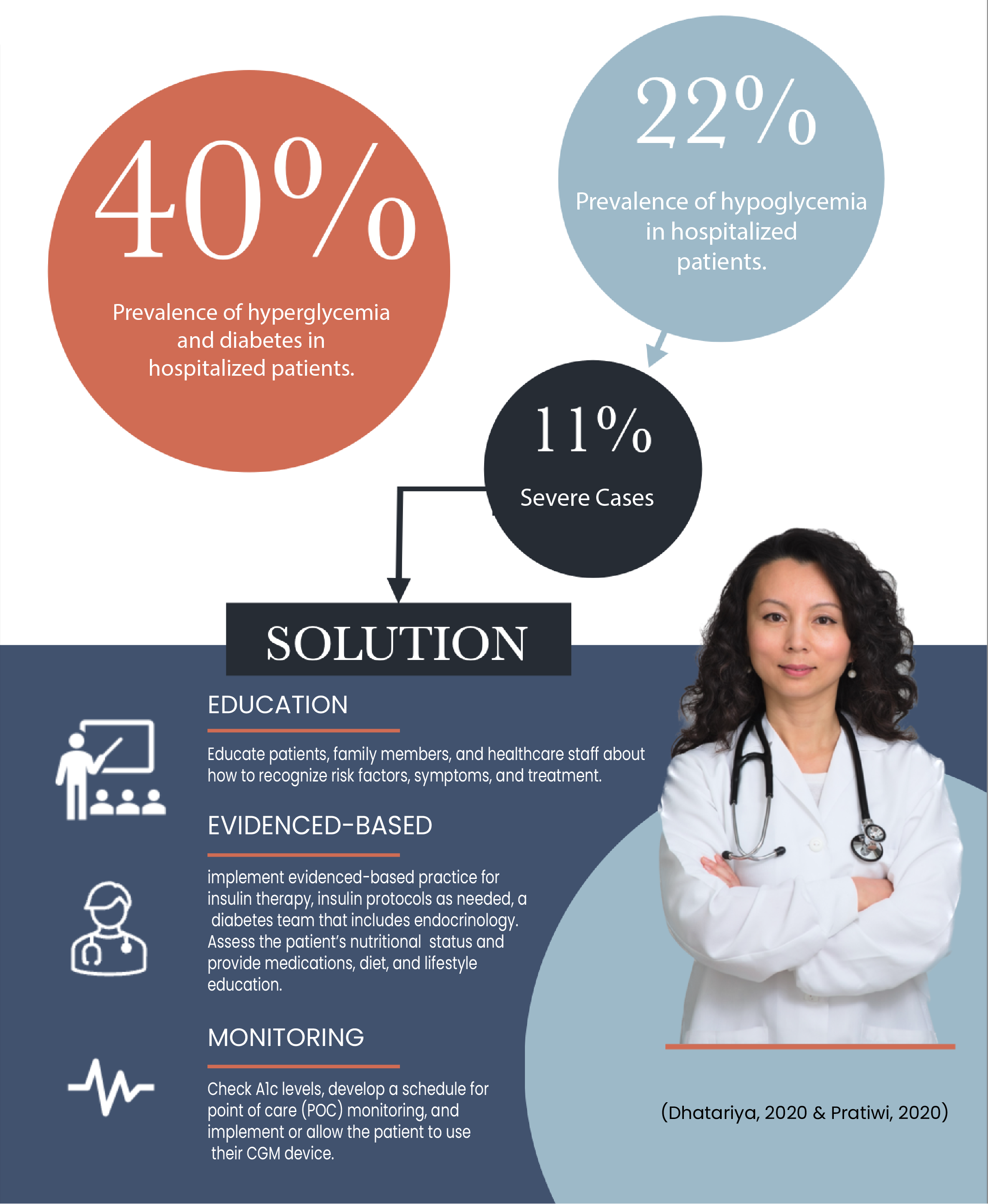Blood Sugar Managment in the Hospital
Continuous
Glucose
Monitoring
By: Vincent Alvarez, RDN, CNSC, NSCA-CPT
Last Updated: August 19, 2023

A CGM is a wearable device to help track blood sugars over time. It is shown to improve patient outcomes in hospitalized patients with hyperglycemia and diabetes. Blood sugar numbers are transmitted to a receiver every several minutes that the healthcare team can monitor from afar (Perez-Guzman, 2021).

What are the benefits of the CGM device in the hospital setting?

Decreases Frequency of Fingersticks
The current practice of checking blood sugars in the hospital is called the point of care (POC) testing. This requires trained staff to frequently check a patient’s blood sugar manually by poking them with a needle. The CGM, however, allows for continuous glucose monitoring without the interruption from healthcare staff.

Decreases Hyperglycemic Episodes
Hyperglycemia in the hospitalized patient leads to poor clinical outcomes. It results in increased mortality, infections, and hospital complications. When blood sugar is too high, it can reduce immune function and trigger inflammation, making healing difficult (Dhatariya, 2020).

Decreases Hypoglycemic Episodes
Hyperglycemia, which is blood sugars < 70 mg/dl, is a serious condition. Severe hypoglycemia is associated with cardiac arrhythmias, cardiac ischemia, seizures, brain damage, and death. Once a person experiences a hypoglycemic episode, their likelihood of having another episode increases (Griffling, 2016).
Hyperglycemia and Hypoglycemia

History of the CGM
The idea of an implantable glucose sensor has been an idea for over 40 years. The continuous glucose monitoring (CGM) device was born out of that original idea (Didyuk, 2020).

Minimed 1999
Minimed marketed the first FDA approved CGM in 1999 for outpatient use. This implantable device could last 3 days, with calibration needed every 6-12 hours (Didyuk et al., 2021).
Major Companies in the USA
Today there are 4 companies in the USA that offer CGMs: Abbott, Dexcom, Medtronic, and Senseonics Eversence.
(Continuous, 2020)

Making Progress
The early CGM had wires and needed a receiver to get the blood sugar readings that only went to the person’s healthcare provider. Today, these devices are wireless and can transmit the blood glucose readings to the person’s app on their smart phone.
In addition, they can now be implanted for up to 2 weeks at a time with no calibration needed, unless there is a discrepancy like during dehydration.
The CGM recently received FDA approval for hospital use under certain conditions.
Research is ongoing to make the future CGM device with a longer life span, user friendly, and inexpensive.
(Didyuk et al., 2021)
Summary
The CGM device has shown to improve the quality of life considerably for those facing hyperglycemia and diabetes. It was originally FDA approved for the outpatient setting. The hospital setting now welcomes the CGM device as a way to significantly improve clinical outcomes for people with hyperglycemia and diabetes, and to quickly intervene in cases of hypoglycemia. We look forward to educating the healthcare team so the CGM device is implemented appropriately, safely, and timely. It is a tool that will change how we care for our patients, for the better!

Vincent Alvarez
RDN, CNSC, NSCA-CPT
An accomplished Registered Dietitian and Certified Nutrition Support Clinician working in the hospital setting for over 25 years. He provides direct patient nutrition care for a variety of health challenges, which include people who need to manage their blood sugars. He welcomes the introduction of the CGM device in the hospital setting and realizes that it will be a team effort to implement it correctly and safely. He has no conflict of interest or bias with any CGM device companies.
Contact
valvarezrd@gmail.com
619.804.5043
References
Clubbs-Coldron, B., Coates, V., Khamis, A., & MacRury, S. (2023). Use of continuous glucose monitoring in non-ICU hospital settings for people with diabetes: a scoping review of emerging benefits and issues. Journal of Diabetes Science and Technology, 17(2), 467-473.
Continuous Glucose Monitors (CGM). (2020, August 14). Diatribe. https://shorturl.at/avwTX
Dhatariya, K., Corsino, L., & Umpierrez, G. E. (2020). Management of diabetes and hyperglycemia in hospitalized patients. Endotext. https://www.ncbi.nlm.nih.gov/books/NBK279093/
Didyuk, O., Econom, N., Guardia, A., Livingston, K., & Klueh, U. (2021). Continuous glucose monitoring devices: Past, present, and future focus on the history and evolution of technological innovation. Journal of Diabetes Science and Tchnology, 15(3) pp. 678-683.
Griffing, K. L. (2016). Hypoglycemia prevention in hospital patients: a quality improvement project to prevent severe and recurrent hypoglycemia. Clinical Diabetes, 34(4), 193-199.
Perez-Guzman, M.C., Shang, T., Zhang, J.Y., Jornsay, D., & Klonoff, D.C. (2021). Continuous glucose monitoring in the hospital. Journal of Endocrinology and Metabolism, 1(36), pp240-255.
Pratiwi, C., Mokoago, M. I., Kshanti, I. A. M., & Soewondo, P. (2020). The risk factors of inpatient hypoglycemia: A systematic review. Heliyon, 6(5).
Southcoast Health. (2012, November 29). Continuous glucose monitoring systems. [Video]. YouTube. https://www.youtube.com/watch?v=5IZ9aC5B2yo&t=103s


